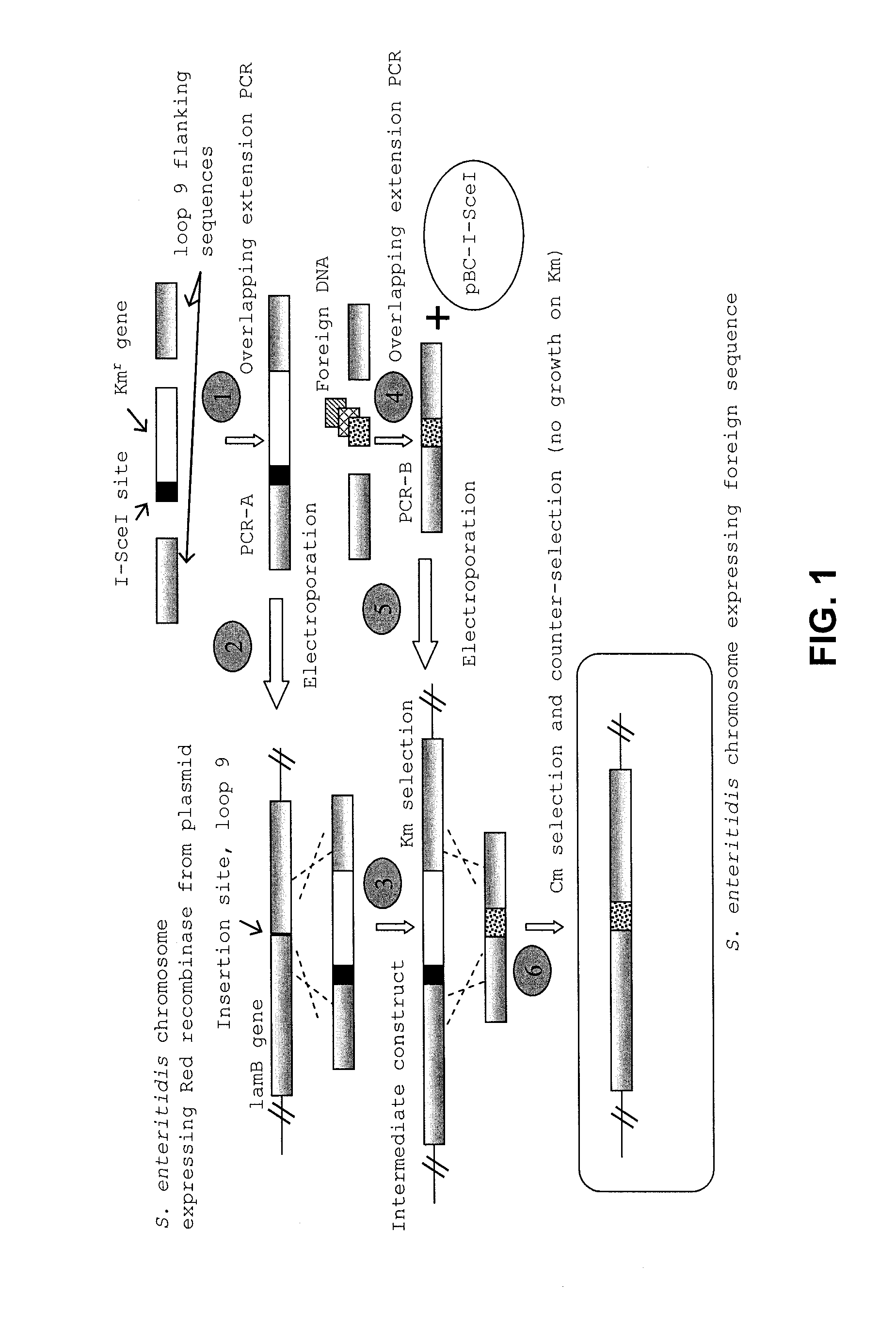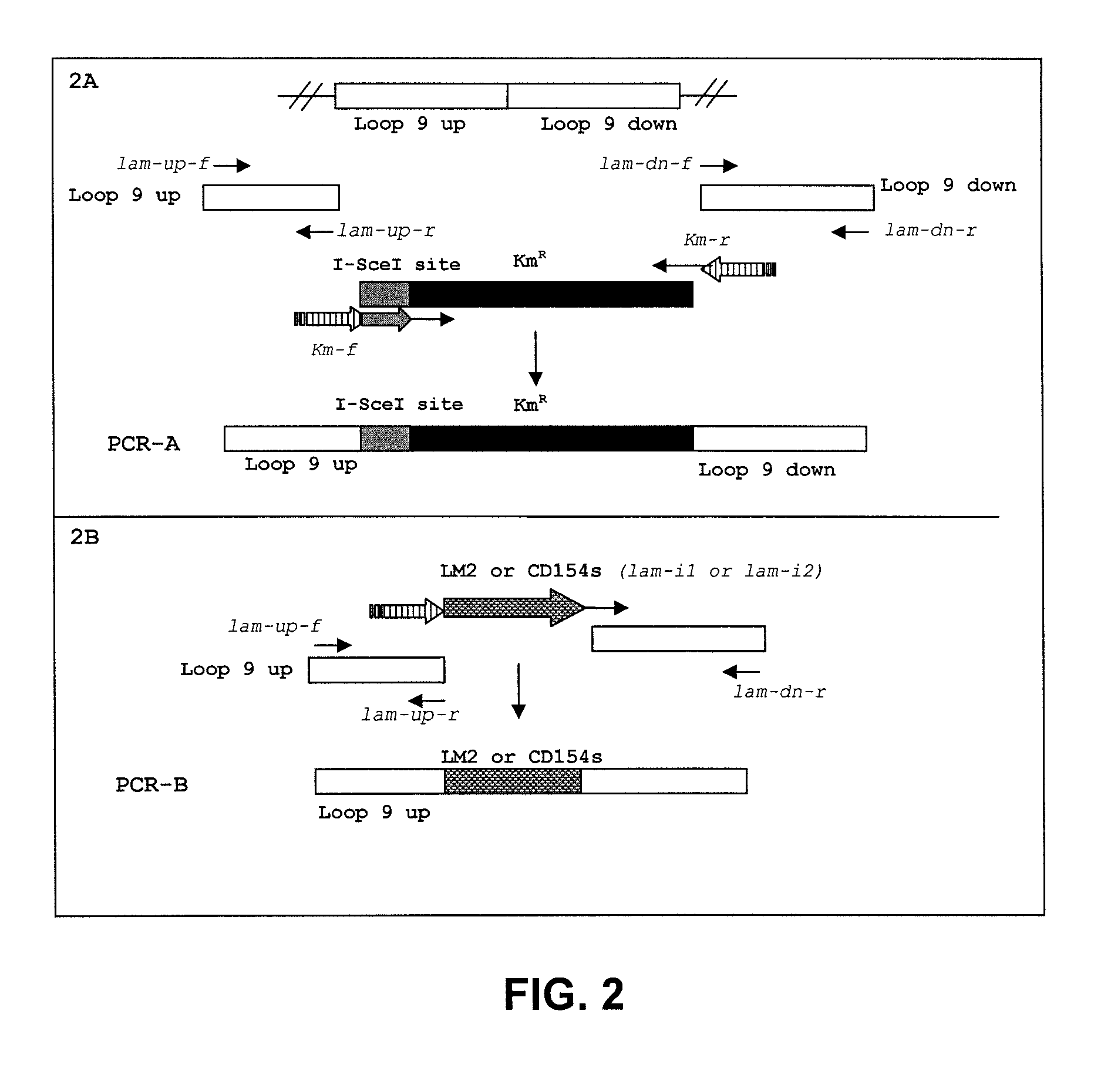Compositions and methods of enhancing immune responses
a technology of immune response and composition, applied in the field of compositions and methods of enhancing immune responses, can solve the problems of devastating outbreaks and threatening to have a huge economic impact, and achieve the effect of reducing morbidity and reducing morbidity
- Summary
- Abstract
- Description
- Claims
- Application Information
AI Technical Summary
Benefits of technology
Problems solved by technology
Method used
Image
Examples
example 1
Construction of M2e and M2e / CD154 Inserts
Strains and Culture Conditions
[0055]All plasmids were first maintained in TOP10 E. coli cells (Invitrogen, Carlsbad, Calif., USA) unless described otherwise. Salmonella enteritidis 13A was used for introduction of mutations. Salmonella enteritidis strain 13A was a field isolate available from USDA / APHIS / NVSL and deposited with the ATCC as deposit number PTA-7871. Bacteria carrying plasmid pKD46 were grown at 30° C. Other bacteria were grown at 37° C. Plasmid curing was conducted at 37° C.
[0056]Luria-Bertani (LB) media was used for routine growth of cells, and SOC media (Invitrogen, Carlsbad, Calif., USA) was used for phenotypic expression after electroporation. When appropriate, the following antibiotics were added to the media: ampicillin (Amp) at 100 μg / ml, kanamycin (Km) at 50 μg / ml, and chloramphenicol (Cm) at 25 μg / ml.
Plasmids
[0057]Plasmids pKD46, pKD13, and pBC-I-SceI were described previously (Datsenko and Wanner, PNAS 2000, 97:6640-66...
example 2
Attenuation of M2e or M2e / CD154 Mutants / Inserts
[0067]Attenuation of SE13A was achieved by deletion mutation of the aroA gene and / or the htrA gene. Mutation of the aroA gene, a key gene in the chorismic acid pathway of bacteria, results in a severe metabolic deficiency which affects seven separate biochemical pathways. Mutation of the htrA gene reduces the cell's ability to withstand exposure to low and high temperatures, low pH, and oxidative and DNA damaging agents and reduces the bacteria's virulence.
[0068]To achieve deletion mutations in SE13A, the target gene sequence in the bacterial genome of S. enteritidis was replaced with the Km resistant gene sequence. This was completed using overlapping extension PCR and electroporation of the PCR products as described above. The Km resistance gene was targeted into the genomic region containing the genes of interest (aroA or htrA) by flanking the Km resistance gene with 200-300 base pairs of sequences homologous to the genes of interest...
example 3
Confirmation of Cell Surface Expression of M2e and CD154
[0069]Cell surface expression of the M2e and CD154 inserts was confirmed with a simple antibody / antigen precipitation reaction. In short, polyclonal antibodies were made against the amino acid sequences of both M2E-LM2 (EVETPIRN; SEQ ID NO:5) and CD154 (WAEKGYYTMSC; SEQ ID NO:6) conjugated to a carrier protein (KLH). The resulting antibodies were then incubated with SE13A wildtype (no inserts) or SE13A with either the M2e-LM2, the CD154 or the M2e-LM2 and CD154 combined insert on a glass plate at room temperature and allowed to incubate for 30 seconds. Cell surface expression was determined by the presence of a precipitate. Results are shown in Table 2. A positive precipitation reaction is indicated by a (+) sign and a negative precipitation reaction is indicated by a (−) sign. The results demonstrate that the SE13A wildtype did not react with the M2e and CD154 peptide antibodies, while the strains expressing M2e, CD154 or M2e ...
PUM
| Property | Measurement | Unit |
|---|---|---|
| temperature | aaaaa | aaaaa |
| volume | aaaaa | aaaaa |
| pH | aaaaa | aaaaa |
Abstract
Description
Claims
Application Information
 Login to View More
Login to View More - R&D
- Intellectual Property
- Life Sciences
- Materials
- Tech Scout
- Unparalleled Data Quality
- Higher Quality Content
- 60% Fewer Hallucinations
Browse by: Latest US Patents, China's latest patents, Technical Efficacy Thesaurus, Application Domain, Technology Topic, Popular Technical Reports.
© 2025 PatSnap. All rights reserved.Legal|Privacy policy|Modern Slavery Act Transparency Statement|Sitemap|About US| Contact US: help@patsnap.com



